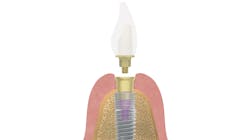Pearls for Your Practice: MIS Connect screw-retained abutment system
In 2017, I attended the American Academy of Restorative Dentistry (AARD) meeting in Chicago, Illinois. Day one of AARD features seven 45-minute presentations from giants in the field of dentistry. That day in Chicago, I had the pleasure of seeing Dr. Tomas Linkeviius present and I was swept away for the entire 45 minutes. The title of his presentation was “Zero Bone Loss Concepts,” which he has since published as a textbook.
As a dentist who restores implants, Zero Bone Loss Concepts has been a watershed publication. It has become hard-and-fast knowledge that we can expect bone loss on implants down to the first thread. This crestal bone loss has been assumed to be normal and routine. Dr. Linkeviius contends that we should not concede this precious bone. That’s what the entire text is about.
The big question is, how can we make zero bone loss the norm? The textbook features a ton of information on the subject. We will explore only one idea here: the idea of a platform switched, stable implant-abutment connection. That can be achieved with the MIS Connect system.
Connect is a “stay-in” abutment system that helps us to avoid creating inflammation and interference at the peri-implant seal. Think about all the times we have to meddle with this critical area of the implant after it is placed. The implant goes in and a healing abutment is added. At some point in a few weeks, the surgeon takes off the healing abutment to inspect the implant. This creates inflammation at that critical crestal bone area. How about when the restorative dentist takes off the healing abutment to attach an impression coping or scan body? More trauma. Or when they take off the impression coping or scan body and reattach the healing cap? Or when the healing cap comes off and the final abutment is installed? Every time we mess with this interface, we create inflammation, which can harm bone level around the implant.
Connect takes that out of the mix. The Connect abutment is delivered at the time of surgery, torqued to an appropriate level, and never removed. All of our restorative parts attach to the Connect, including the final restorative abutment. Connect allows us to move the interface up and away from the crestal bone. This distances the bacteria and inflammation from the bone level. The conical connection of the Connect into MIS implants eliminates movement of the abutment platform. If all other factors are managed well, zero bone loss results around the implant.
The Connect system is compatible with MIS conical connection implants (C1 and V3) and comes in a variety of tissue heights. This is chosen based on the depth of implant placement. Ideally, a Connect abutment should be chosen that is at least 1 mm above the crestal bone and 1.5 mm below the expected gingival margin. MIS makes a full suite of components to engage the Connect system for the restorative process.
We should be taking every precaution we can to prevent crestal bone loss around implants. Some of these precautions are surgical and some are restorative. As a restorative dentist, having a tool such as the Connect system helps ensure that I am doing my part to keep bone where it should be! Triple into the left field corner for MIS!
More: Dental implant contamination: 3 reasons behind a late-stage failure
Joshua Austin, DDS, MAGD, writes the Pearls for Your Practice column in Dental Economics. After graduating from the University of Texas Health Science Center Dental School, Dr. Austin associated for several years. In October of 2009, he opened a solo general practice in a suburban area of San Antonio, Texas. Dr. Austin is involved in all levels of organized dentistry and can be reached at [email protected].
About the Author
Joshua Austin, DDS, MAGD
Joshua Austin, DDS, MAGD, is a graduate and former faculty member of the University of Texas Health Science Center at San Antonio School of Dentistry. Author of Dental Economics’ Pearls for Your Practice column, Dr. Austin lectures nationally on products, dental technology, online reputation management, and social media. He maintains a full-time restorative dentistry private practice in San Antonio, Texas. You may contact Dr. Austin at [email protected].
Updated June 21, 2023

